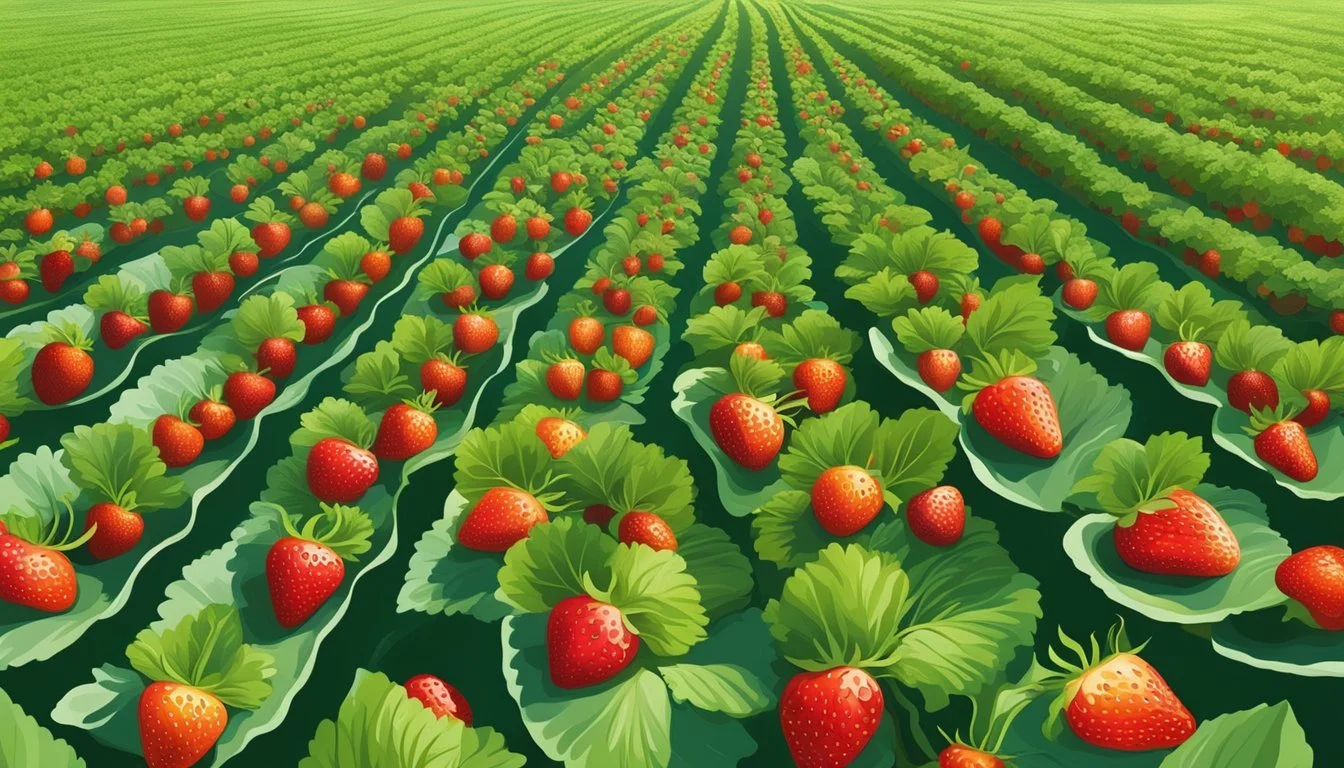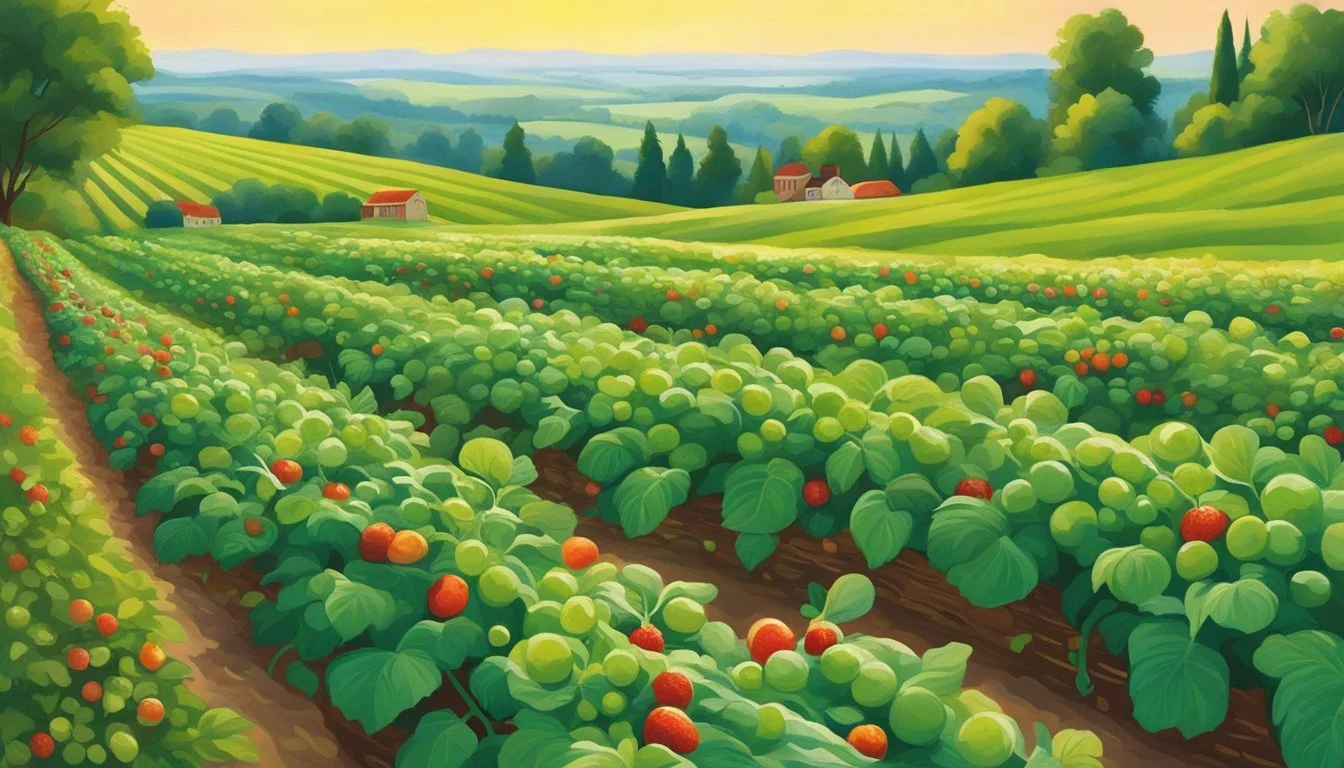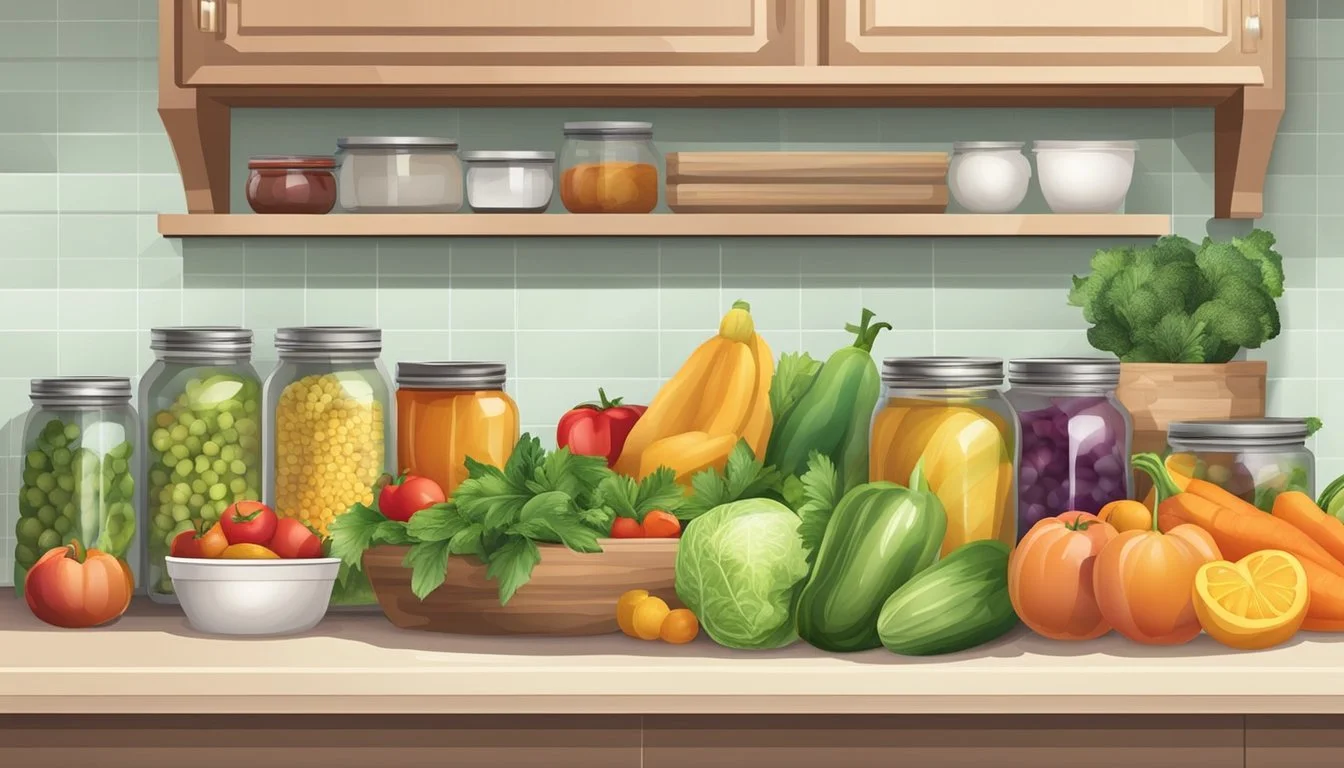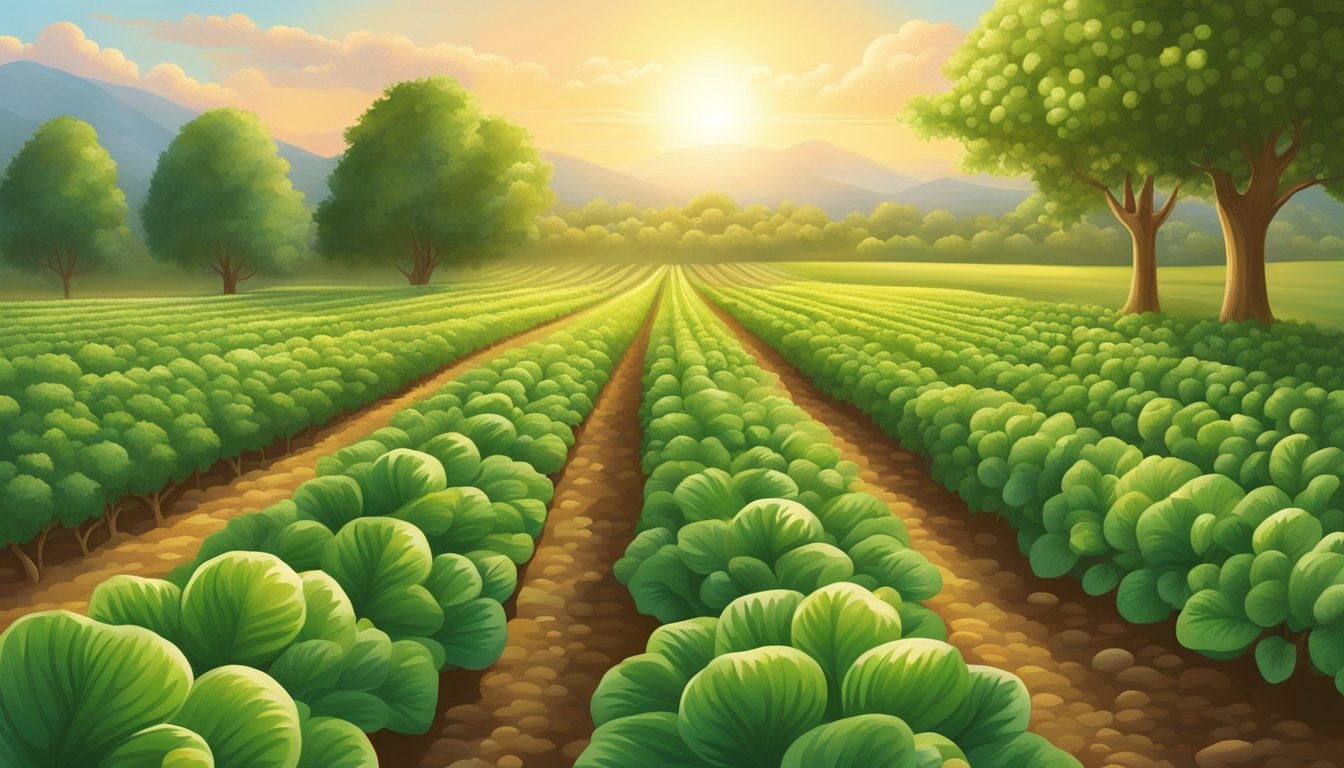Montana Seasonal Fruit & Vegetables in June
A Fresh Guide to Local Produce
This Article is Part of our Montana Seasonal Fruit & Veg Calendar
Montana's agricultural landscape flourishes in June, signifying the onset of summer and the arrival of a diverse array of seasonal fruits and vegetables. This period marks a vibrant time of year when farmers' markets and local stores begin to stock fresh, locally grown produce. The season changes the offerings on tables, integrating the fresh flavors of June-harvested foods into daily cuisine.
The month of June in Montana presents a particular opportunity for food enthusiasts to explore the state’s seasonal bounty. Locally grown carrots, with their sweet, earthy crunch, become available and can be found fresh from the fields. Leafy greens like chard also make their appearance, adding rich, nutritious options for salads and cooked dishes. Markets are likely to offer these alongside a host of other seasonal produce, reflecting Montana's rich agricultural tradition.
Consumers seeking the freshest ingredients will find that vegetables like cauliflower are in their prime, often accompanied by the edible leaves which can be utilized much like collard greens (how long do collard greens last?) or kale. (What wine goes well with kale?) In embracing the season, one not only enjoys the peak flavors but also supports the local agricultural community, ensuring the sustainability of Montana's seasonal markets and farmers.
Benefits of Seasonal Eating
Eating seasonally in Montana during June allows one to enjoy produce at its peak nutritional value and flavor. It also supports local farmers and the environment.
Nutritional Value
Seasonal fruits and vegetables are typically harvested at their peak of freshness, which means they are more nutrient-dense than those shipped from far away. For instance, leafy greens and herbs are abundant in June in Montana, offering high levels of vitamins and minerals.
Flavor: Seasonal produce is often more flavorful and fresh, which can lead to higher satisfaction and potentially a greater intake of important nutrients.
Environmental Impact
Local, seasonal eating reduces the carbon footprint associated with long-distance transportation. Vegetables like radishes and peas, common in Montana's June markets, require less transit when consumed close to their growing region.
Region: Locally grown food involves less transportation and, as a result, less energy consumption and air pollution.
Economic Advantages
Buying seasonal produce supports the local economy. Locally grown crops, including June favorites like strawberries and cherries (how long do cherries last?) in Montana, provide financial benefits to the region's farmers.
Vegetables in Season: Examples of vegetables in season include:
Radishes
Spinach (What wine goes well with spinach?)
Peas
Seasonal Produce: Financially, this supports regional agricultural communities and helps preserve local farming practices.
Montana's Seasonal Produce Overview
In June, Montana offers a variety of fresh fruits and vegetables. The state's unique climate and soil conditions contribute to the distinct flavors and availability of its produce during this month.
Fruit Highlights
Montana's cooler climate favors the late spring and early summer harvest of certain fruits. In June, the fruits reaching peak freshness include:
Strawberries: These berries are usually at their juiciest and most flavorful.
Cherries: With a later harvest season, cherries begin to become available at local markets.
Vegetable Highlights
The month of June also sees a diverse array of vegetables being harvested throughout Montana. Some notable vegetables include:
Lettuce: Cool weather allows for crisp, fresh leaves.
Spinach: Continues to thrive in the early summer conditions.
Radishes and Green Onions: Small, cool-weather favorites that add crunch and flavor to salads.
Peas: Sugar snap and snow peas are typically harvested in June, offering a sweet taste.
Beets (how long do beets last?): Earthy and deep-flavored, beets start to appear in markets.
June's Harvest Calendar
In Montana, June marks a vibrant shift in the local produce offerings as spring transitions into summer. This period sees an array of fruits and vegetables maturing for harvest, offering a bounty that is both fresh and flavorful.
Early June Produce
Early June in Montana heralds the arrival of berries and lettuce, both freshly plucked from the fields. One can find strawberries beginning their season, presenting consumers with their first taste of local summer sweetness.
Berries: Strawberries
Lettuce: Green leaf, Red leaf, Romaine
Mid June Availability
By mid-June, the selection expands significantly. Berries continue to thrive, with raspberries joining the mix. Peas, an emblem of spring's end, come into prominence, and the varieties of lettuce diversify further.
Berries: Strawberries, Raspberries
Peas: Garden peas, Sugar snap peas
Lettuce: Iceberg, Butterhead, Oak leaf
Late June Selections
As the month progresses, late June sees the peak of berry season, with strawberries and raspberries in abundance. Additionally, Montana fields yield robust crops of peas and a rich assortment of lettuce, offering a blend of taste and nutritional value.
Berries: Strawberries, Raspberries
Peas: Snow peas
Lettuce: Summer crisp, Lollo Rosso, Batavia
Preparation and Storage Tips
When it comes to enjoying Montana's seasonal fruits and vegetables in June, proper preparation and storage are key. They ensure that the quality and flavor of the produce is preserved from the market to the kitchen.
Keeping Fruits Fresh
For fruits such as strawberries and cherries that are in season in June, refrigeration is crucial. They should be stored in the crisper drawer of the refrigerator in a breathable container, like a paper bag, to maintain freshness. Berries are delicate and should be washed just before consumption or use in recipes like pies or salads. For longer-term storage, fruits can be frozen on a flat tray and then transferred to airtight containers, making them perfect for smoothies or as a cold addition to yogurts.
Storing Vegetables Properly
Leafy greens, commonly harvested in June, thrive when stored in the refrigerator, preferably in the crisper drawer to retain their crisp texture. They should be washed and dried before storage to prevent spoilage, with a paper towel added to the bag to absorb excess moisture. Root vegetables like beets and carrots are best kept cool and dark in a pantry or cellar. For use in roasted vegetable dishes, they can simply be cleaned and cut as needed, maintaining their structure and nutrient content.
June's Featured Recipes
With the arrival of June, Montana's markets brim with fresh produce, offering an opportunity to explore a variety of recipes. This section showcases recipes that highlight June's freshest fruits and vegetables through vibrant salads, hearty main courses, and delightful desserts.
Salad Creations
Strawberry Spinach Salad: A refreshing combination, this salad pairs ripe strawberries with crisp Montana-grown spinach. Tossed with slivered almonds and a poppy seed dressing, it strikes a perfect balance of sweet and savory.
Cherry Tomato and Cucumber Salad: Cherries are in their prime during June. This salad uses cherry tomatoes, which bring a burst of flavor, complemented by the crunch of fresh cucumbers and a hint of fresh mint for an invigorating side dish.
Main Course Ideas
Grilled Vegetable Platter: Stars of the season, zucchini and bell peppers join a variety of greens like kale and chard on the grill. Served with a drizzle of balsamic glaze, these vegetables become a centerpiece for any summer meal.
Beetroot and Goat Cheese Tart: Showcasing the earthy sweetness of beets, this tart marries them with creamy goat cheese on a flaky pastry base. It's a sumptuous main course that celebrates the simplicity of Montana's seasonal produce.
Dessert Inspirations
Rustic Apricot Galette: This simple, free-form tart allows the natural sweetness of apricots to shine. Encased in a buttery crust, it's a delightful end to any meal, emphasizing the full flavor of June's stone fruits.
Berry Parfait: Layering yogurt with an assortment of June's ripe berries creates a visually appealing and delicious dessert. The berries' natural sugars make this treat sweet without the need for much added sugar.
Local Markets and Festivals
In June, Montana's local markets brim with fresh produce and the state hosts a variety of seasonal events that celebrate the region's agricultural bounty.
Farmers' Markets
Montana is home to an array of farmers' markets that offer seasonal fruits and vegetables. Each market provides a unique opportunity for residents and visitors to purchase fresh, local produce directly from growers.
Bigfork Farmers Market Co-op
Dates: June 12-Oct 13
Hours: 3-6PM
Bigfork Village Market
Dates: June 7-Sept 27
Hours: 5-7:30PMColumbia Falls Community Market
Dates: May 20-Sept 30
Hours: 5-8:30PMKalispell Farmers Market
Dates: May 1-Oct 9
Hours: 9AM-12:30PMWest Glacier Artisan Market
Dates: June 18-Sept 3
Hours: 3-6PMWhitefish Downtown Farmers Market
Dates: May 25-Sept 28
Hours: 5-7:30PM
Seasonal Events
Montana's seasonal events in June are vibrant celebrations that often coincide with the harvest times. These events typically include more than just an opportunity to purchase fresh produce; they're also rich with local culture and traditions.
Montana Mule Days
Date: June 3-5, 2022
Location: Ravalli County Fairgrounds, Hamilton, MT
Features: This event showcases the state's largest mule and donkey show, complete with riding and cattle driving events.
Guidance for Gardeners
For gardeners in Montana, the month of June is a pivotal time for planting and tending to a variety of fruits and vegetables. It marks the transition into summer, requiring careful consideration of planting dates, maintenance routines, and harvesting methods due to the increasing heat.
Planting Tips
In June, gardeners should focus on planting heat-tolerant varieties that can withstand Montana’s summer temperatures. Ideal vegetables to plant include:
Root vegetables: Beets and carrots can be sown directly into the soil.
Leafy greens: Plant kale and lettuces in partially shaded areas to protect them from midday sun.
Cruciferous vegetables: Broccoli and cauliflower can be started now for a fall harvest.
Planting should occur in well-draining soil with plenty of organic matter to retain moisture during heat spells. Spacing between plants is crucial to ensure they receive adequate nutrients and have room for growth.
Maintenance and Harvesting
Regular maintenance in the summer months includes:
Watering: Water deeply and less frequently to encourage strong root systems and to cope with the dry conditions, preferably in the morning or evening to reduce evaporation.
Mulching: Apply mulch to conserve moisture, regulate soil temperature, and suppress weeds.
Pest control: Monitor for pests common in the region and address with appropriate means.
Harvesting should be done early in the day when temperatures are cooler, which helps to ensure the best flavor and shelf-life. Gardeners should harvest regularly to encourage further production, especially for fast-maturing crops like spinach and peas.
By following these guidelines, Montana gardeners can maximize their garden’s productivity throughout the summer season.
Montana's Farming Challenges
Montana’s farmers face a unique set of challenges due to the state's varied topography and climate, particularly during June, a pivotal month in the agricultural calendar.
Weather Considerations
Montana is characterized by its short growing season and dynamic weather conditions which can include sudden temperature shifts. Average temperatures in June can still present frost risks, especially in higher elevations. Rainfall during this season tends to be moderate, but its inconsistency can affect soil moisture levels critical for crop establishment. As a result, farmers in the region must be prepared for:
Frost: Protecting emerging plants is crucial as frosts can occur unexpectedly.
Precipitation Variability: Efficient irrigation strategies become vital in areas where rainfall is sparse.
Pest Management
With the onset of warmer weather, June brings about increased pest activity in Montana. Farmers must be vigilant in monitoring and managing pests to protect their yields. Key pests include:
Aphids and cutworms, which can cause significant damage to a variety of crops.
Weeds that compete for nutrients and water, especially in the nutrient-rich soils of the Golden Triangle.
Effective pest management often necessitates the use of integrated pest management strategies, combining biological, cultural, and chemical controls. This approach aids in maintaining ecosystem balance and reducing the adverse effects of pesticides.
Conclusion
June in Montana offers a bounty of fresh fruits and vegetables, marking the onset of the summer growing season. Communities thrive on the support for local agriculture, enjoying crisp flavors that are both nutritious and enjoyable.
Fruits: Local markets begin to see a variety of berries, including strawberries and raspberries. Their ripe, sweet flavors are perfect for both fresh consumption and delightful summer desserts.
Vegetables: The range includes leafy greens such as spinach and kale, peas, and an assortment of herbs that bring freshness to any dish. These crops benefit from the cooler nights and warm days, which enhance their flavors right before harvesting.
Local farm-to-table initiatives gain momentum during this month, promoting the sustainability of Montana's agricultural landscape. Purchasing seasonal produce not only supports these efforts but also ensures that individuals are getting nutrient-dense food at its peak flavor.
Suggested Produce for Community Support:
Berries: Strawberries, Raspberries
Greens: Spinach, Kale
Flavorful Herbs: Basil, Mint
Summer Staples: Peas, Beets
They take pride in the unique climatic conditions of the state, which contribute to the distinct taste and texture of the produce. Embracing these seasonal offerings reinforces the connection between the land and the local communities, fostering a resilient food system while celebrating the tastes of summer.










